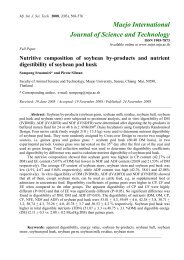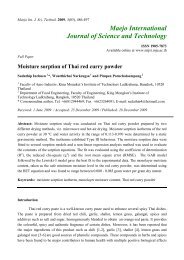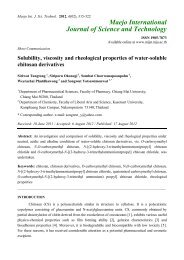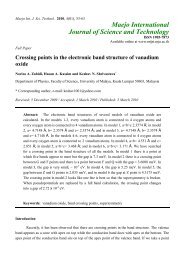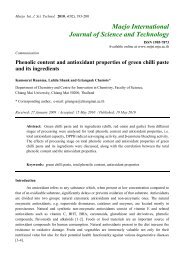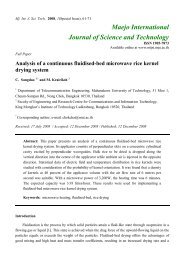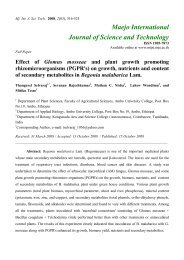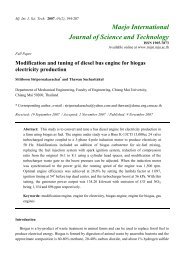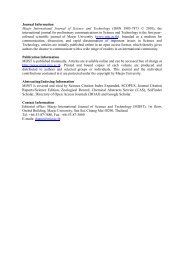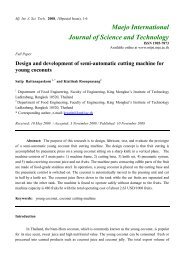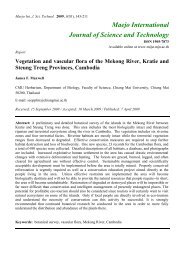ISSN 1905-7873 © 2012 - Maejo International Journal of Science ...
ISSN 1905-7873 © 2012 - Maejo International Journal of Science ...
ISSN 1905-7873 © 2012 - Maejo International Journal of Science ...
You also want an ePaper? Increase the reach of your titles
YUMPU automatically turns print PDFs into web optimized ePapers that Google loves.
38 <strong>Maejo</strong> Int. J. Sci. Technol. <strong>2012</strong>, 6(01), 28-46<br />
In fast-flowing water, there are diatoms such as Achnanthes and Cocconeis that can attach<br />
on rocks and other hard surfaces [24]. Similarly, in this study, Cocconeis spp. were found as<br />
dominant species at HG during summer 2007 with high water velocity. In slower flowing water,<br />
Melosira varians and various species <strong>of</strong> Synedra, Gomphonema and Cymbella are found on hard<br />
substrata [24]. Throughout the sampling period, Gomphonema spp. were also observed at LG<br />
located about 100 metres downstream from a small dam, where the flow rate <strong>of</strong> water was<br />
extremely low.<br />
Species <strong>of</strong> Benthic Diatoms in Relation to Physico-Chemical Properties <strong>of</strong> Water by Cluster<br />
Analysis<br />
Twenty nine common diatom species were arranged in groups <strong>of</strong> sampling sites detected by<br />
cluster analysis <strong>of</strong> physico-chemical parameters <strong>of</strong> water quality at 80% similarity. The number <strong>of</strong><br />
benthic diatoms in each group was calculated by Minitab program to find the significant difference<br />
and significant correlation between groups. The relationship between diatom community<br />
composition and water quality variables was determined using statistical techniques. Each sampling<br />
site had distinct water physico-chemical properties. At 80% similarity, the dendrogram divided<br />
sampling sites into eleven distinct clusters <strong>of</strong> characteristic water quality types: groups A to I 2<br />
(Figure 5 and Table 4). It was found that all sampling sites in groups A (n=3) and B (n=9) and some<br />
in group C (n=3) were those during December 2006 (cool dry season). Group E, the biggest group<br />
(n=54), was composed <strong>of</strong> sampling sites during May 2006 (summer) and some sites in two cool dry<br />
seasons.<br />
The values <strong>of</strong> physico-chemical parameters in each group were calculated by Minitab<br />
program to find significant differences and correlations between groups A to I 2 as shown in Table 5.<br />
It was found that groups A, C, G and H showed a non-significant correlation with NO 3 - -N<br />
concentration. Group F 1 showed higher concentrations <strong>of</strong> NO 3 - -N (average <strong>of</strong> 1.33 mg/L) than<br />
groups B, D, E, F 2 and I 1 (P




